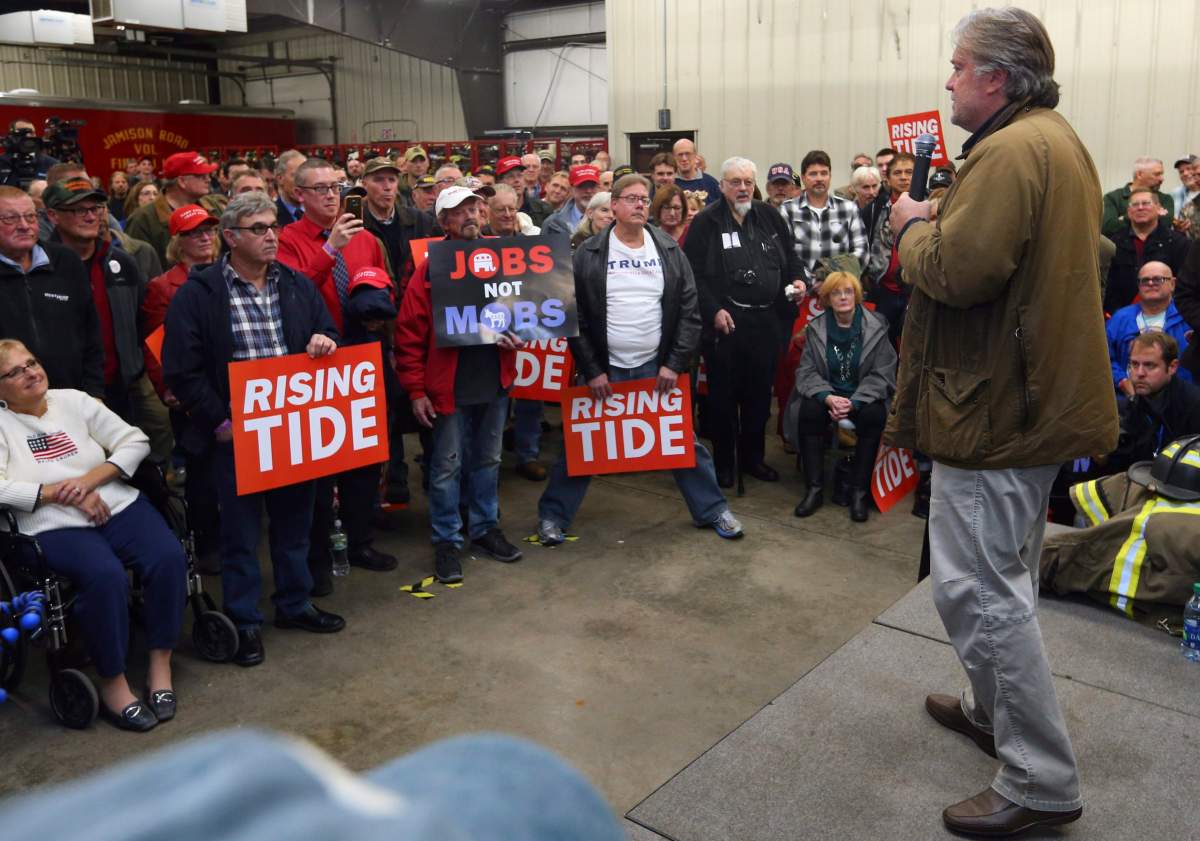Stephen K. Bannon, the man considered the architect behind Donald Trump‘s electoral victory, had a Toronto audience laughing, chortling and exclaiming as if in disbelief as he sparred with ex-George W. Bush administration staffer David Frum in a Munk Debate at Roy Thomson Hall on Friday night.

Bannon and Frum stayed mostly civil during their debate, in which the ex-Trump strategist was interrupted early on by a protester who unfurled a banner reading, “No hate, no bigotry, no place for Bannon’s white supremacy.”
WATCH: Protesters yell at people entering Munk Debate in Toronto with Steve Bannon

The pair squared off over the the following resolution: “Be it resolved, the future of western politics is populist not liberal.”
From there unfolded a debate that largely remained even-tempered but did prove contentious in at least one section.
Throughout, Bannon drew many of the crowd’s most notable reactions, ranging from anywhere between applause, laughs, boos and gasps at his assertions.
He also made a number of assertions that don’t exactly stand up to criticism.
Here are a number of Bannon’s statements that warranted further scrutiny:
‘There is no correlation, none, there’s no correlation between the rhetoric of our movement and what has gone on’
Bannon said this after moderator Rudyard Griffiths asked him about having attended rallies where opponents have been called “un-American” and where political violence has taken place.
Bannon didn’t let Griffiths finish, immediately denying that there is any correlation between his movement and political violence.
This came days after Florida man and Trump supporter Cesar Sayoc was arrested and charged with five federal crimes in connection with pipe bombs that were sent to a number of Trump critics including ex-president Barack Obama, former presidential nominee Hillary Clinton and elected Democrats.

Get breaking National news
Sayoc was “obviously mentally ill for many, many decades,” Bannon said.
Frum challenged him on this point, saying that everyone who received a pipe bomb was a “named target of Donald Trump.”
Bannon later said, “Trump never made them targets, maybe in speeches. He’s never sat there and said they’re targets. You can’t equate the two.”
‘The violence that’s brought up by the Democratic left is far worse than is brought up by our movement’
Bannon later expounded on what he called violence by the “Democratic left” as part of that exchange.
He talked about a video showing members of activist group Antifa beating up Trump supporters.
“The rhetoric on the left is just as bad, the opposition media will not report it,” he said.
Bannon may have just been largely addressing rhetoric, but there’s plenty of evidence to suggest that right wingers have been implicated in more violent incidents than left wingers have.
Just this week, CNN host Don Lemon noted that “the biggest terror threat in this country is white men, most of them radicalized to the right.”
He brought up reports like one by the Government Accountability Office (GAO) showing that 106 people were killed by far right extremists in 62 incidents from Sept. 12, 2001 to Dec. 31, 2016.
That same report found no fatalities from far-left extremist groups in that time.
Lemon also addressed statistics from the Anti-Defamation League that found right-wing extremists responsible in 74 per cent of incidents in which homegrown perpetrators had killed people.
Left-wing extremists were found to be responsible in only two per cent of cases.
‘Look at the results today. Lowest black unemployment in history, lowest Hispanic unemployment in years’
“Trump’s economic nationalism doesn’t care about your race, your ethnicity, your religion, your colour,” Bannon said, to laughs from the audience.
As he spoke about economic nationalism, he seemed to tie it together with the state of unemployment in the U.S., which has indeed shown low unemployment for African-American and Hispanic people.
This is a talking point that Trump has used as he has pushed for the African-American vote.
But analysis has shown that it’s problematic for him to take credit for low unemployment within this demographic.
The U.S. Census Bureau did, indeed, show black unemployment at 6.2 per cent last month, the lowest it’s been in 10 years.
But it’s been declining since 2011, when Barack Obama was president. And it’s still almost double the rate for white Americans (3.3 per cent) and it’s higher than it is for Asians (3.2 per cent) and Hispanics (4.4 per cent).
‘Why is the nation-state, that’s been with us since the Treaty of Westphalia, why is it so scorned?’
Bannon said this as he talked about nationalist movements in Europe, and Trump’s own claim to be a nationalist.
There’s been some controversy over Trump’s use of the term “nation state,” particularly when he used it in a speech to the United Nations in September 2017.
“The nation-state remains the best vehicle for elevating the human condition,” he said.
A nation-state is defined by UNESCO as a place where cultural boundaries match with political boundaries — where the state “incorporates people of a single ethnic stock and cultural traditions.”
And the specific use of the term “nation-state” was noted by Paul Miller, professor of national security at University of Texas at Austin, in an article for Foreign Policy in January.
Miller noted that the United States has “never come close to being a nation-state,” and that essentially none exist in the world right now.
Perhaps Bannon was merely talking about sovereignty, a concept traced back to the 1648 Treaty of Westphalia, and the ability for a state to make decisions about its fate free of external interference.
In any case, the notion that the nation-state is “with us” is debatable.





Comments